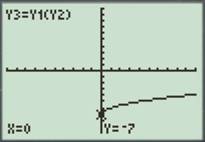
Concept explainers
(a)
To find: The graph of functions
(a)
Answer to Problem 63E
The graph of
Explanation of Solution
Given information: The functions are
Calculation:
To graph a function
First press “ON” button on graphical calculator, press
The display will show the equation,
Press the enter button on the equal sign for the first two equations.
Now, press the

Figure (1)
As observed from the graph of function
The graph of function
To graph a function
First press “ON” button on graphical calculator, press
The display will show the equation,
Press the enter button on the equal sign for the first two equations. Now, press the

Figure (2)
As observed from the graph of function
Also, the graph of function
Therefore, the graph of
(b)
To check: Whether the domain and range conjectures in part (a) are true or not with the help of formula for
(b)
Answer to Problem 63E
The conjectures for the domain and range in part (a) is true.
Explanation of Solution
Given information: The functions are
Calculation:
To find the composite function
As given
The function
The function
To find the composite function
As given
The function
The function
Therefore, the conjectures for the domain and range in part (a) is true.
Chapter 1 Solutions
Calculus 2012 Student Edition (by Finney/Demana/Waits/Kennedy)
Additional Math Textbook Solutions
Precalculus: Concepts Through Functions, A Unit Circle Approach to Trigonometry (4th Edition)
Precalculus
Precalculus (10th Edition)
University Calculus: Early Transcendentals (3rd Edition)
Calculus: Early Transcendentals (2nd Edition)
Calculus: Early Transcendentals (3rd Edition)
 Calculus: Early TranscendentalsCalculusISBN:9781285741550Author:James StewartPublisher:Cengage Learning
Calculus: Early TranscendentalsCalculusISBN:9781285741550Author:James StewartPublisher:Cengage Learning Thomas' Calculus (14th Edition)CalculusISBN:9780134438986Author:Joel R. Hass, Christopher E. Heil, Maurice D. WeirPublisher:PEARSON
Thomas' Calculus (14th Edition)CalculusISBN:9780134438986Author:Joel R. Hass, Christopher E. Heil, Maurice D. WeirPublisher:PEARSON Calculus: Early Transcendentals (3rd Edition)CalculusISBN:9780134763644Author:William L. Briggs, Lyle Cochran, Bernard Gillett, Eric SchulzPublisher:PEARSON
Calculus: Early Transcendentals (3rd Edition)CalculusISBN:9780134763644Author:William L. Briggs, Lyle Cochran, Bernard Gillett, Eric SchulzPublisher:PEARSON Calculus: Early TranscendentalsCalculusISBN:9781319050740Author:Jon Rogawski, Colin Adams, Robert FranzosaPublisher:W. H. Freeman
Calculus: Early TranscendentalsCalculusISBN:9781319050740Author:Jon Rogawski, Colin Adams, Robert FranzosaPublisher:W. H. Freeman
 Calculus: Early Transcendental FunctionsCalculusISBN:9781337552516Author:Ron Larson, Bruce H. EdwardsPublisher:Cengage Learning
Calculus: Early Transcendental FunctionsCalculusISBN:9781337552516Author:Ron Larson, Bruce H. EdwardsPublisher:Cengage Learning





